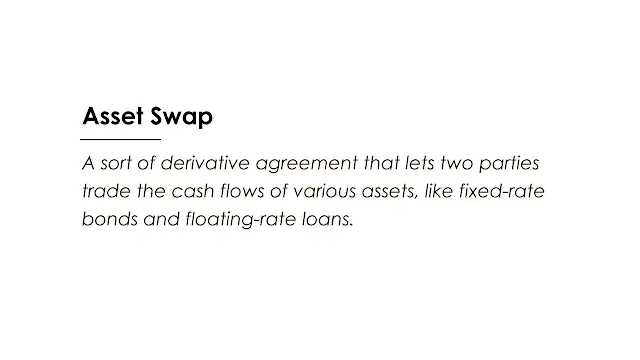 |
| Image: Moneybestpal.com |
Asset swaps are a sort of derivative agreement that lets two parties trade the cash flows of various assets, like fixed-rate bonds and floating-rate loans. Many different risks, including interest rate risk, currency risk, and credit risk, are hedged through asset swaps. In addition, asset swaps can be utilized to increase exposure to various markets or asset classes without actually purchasing or disposing of the underlying assets.
The fixed-for-floating swap is one of the most popular types of asset swaps, in which one party pays a fixed interest rate and receives a floating interest rate based on a reference rate, such as LIBOR. The opposite party exchanges a set rate for a fluctuating rate. This kind of swap can be used to alter a bond's cash flow properties, such as its length, currency, or credit grade.
Consider the case when a buyer purchases a 10-year fixed-rate bond from a US corporation with a 5% annual coupon. The investor wishes to diversify their portfolio by getting exposure to the European market, as well as insulating themselves from the interest rate and currency risks associated with holding the bond. In exchange for agreeing to pay the bank the fixed 5% rate and get a floating coupon based on EURIBOR plus a spread, the investor can swap assets with a bank. The bank consents to give the investor the EURIBOR-based coupon and receive the bond's 5% fixed coupon in exchange.
The investor essentially turns their fixed-rate USD bond into a floating-rate EUR loan by doing this. In hedging their exposure to changes in US interest rates or dollar depreciation, the investor can profit from any increase in EURIBOR or appreciation of the euro versus the dollar. In hedging their exposure to fluctuations in European interest rates or dollar appreciation, the bank can profit from any decline in EURIBOR or depreciation of the euro versus other currencies.
The market value of the bond, the bond issuer's creditworthiness, and the supply and demand for asset swaps are only a few of the variables that affect the spread that the bank pays over or below EURIBOR. The difference between the yield of the bond and the yield of a risk-free bond with the same maturity and currency is measured by the spread, which is sometimes referred to as the asset swap spread or the z-spread.
The asset swap spread can be calculated as follows:
Asset swap spread = (Bond price + Accrued interest) / (Par value) - 1
For example, suppose the bond has a par value of $1000 and a market price of $950. The accrued interest is $25. The asset swap spread is:
Asset swap spread = ($950 + $25) / ($1000) - 1
Asset swap spread = -0.025 or -2.5%
This means that the bank will pay EURIBOR minus 2.5% to the investor in exchange for receiving 5% from the bond.
Asset swaps are practical tools for managing risk profiles and maximizing profits for investors and financial organizations. When there is a discrepancy between the asset swap spread and the fair value of the bond, asset swaps might potentially present arbitrage opportunities. Asset swaps do, however, also include a number of hazards, including counterparty risk, liquidity risk, and basis risk. As a result, both parties should thoroughly assess and manage asset exchanges.
